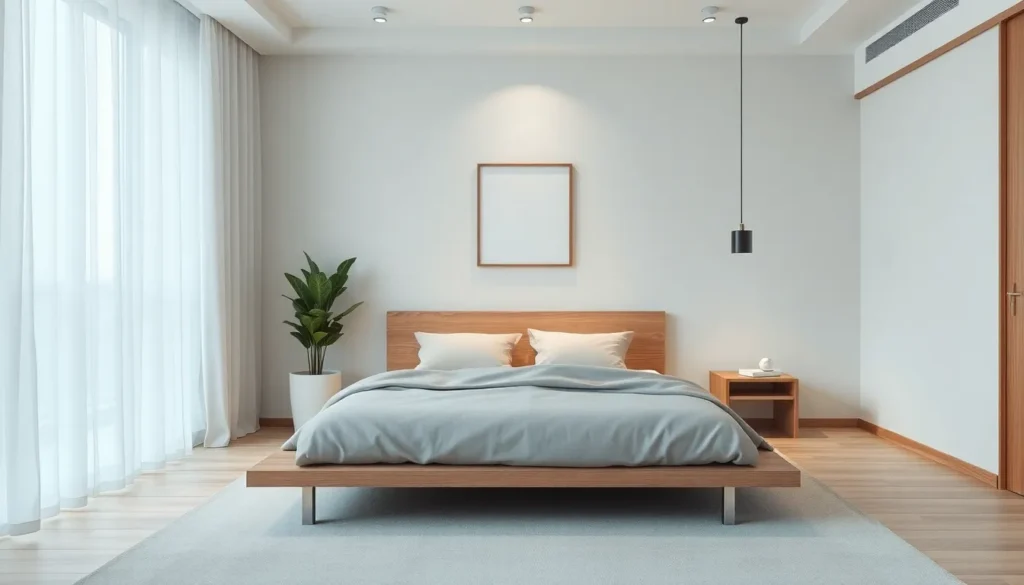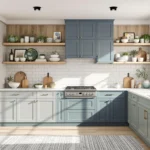Craving a serene sanctuary where you can escape life’s chaos? Modern minimalist bedroom design might be your perfect solution. We’ll show you how to transform your sleep space into a tranquil retreat that embodies the “less is more” philosophy while still maintaining style and personality.
In this guide, we’ve gathered the most stunning modern minimalist bedroom ideas that combine clean lines, neutral palettes, and thoughtful organization. Whether you’re redesigning your entire bedroom or simply looking to declutter your current space, these minimalist approaches will help you create a peaceful environment that promotes better sleep and reduces stress. Let’s explore how strategic furniture placement, intentional decor choices, and smart storage answers can revolutionize your bedroom experience.
10 Modern Minimalist Bedroom Ideas for a Serene Sleep Space
1. Neutral Color Palette with Textural Elements
Creating a peaceful bedroom starts with a neutral color scheme of whites, creams, soft grays, and beiges. These calming hues form the perfect backdrop for minimalist design while making your space feel larger and more open. Add visual interest through textured elements like a chunky knit throw, linen bedding, or a natural fiber rug. Incorporating different textures prevents the neutral palette from feeling flat or boring while maintaining the serene minimalist aesthetic.
2. Platform Bed with Clean Lines
Selecting a low-profile platform bed instantly modernizes your bedroom while embodying minimalist principles. The streamlined design eliminates unnecessary details and keeps visual clutter at bay. Many platform beds offer built-in storage drawers that help maintain the clutter-free environment essential to minimalist spaces. Position your bed as the focal point of the room, allowing ample space around it for easy movement and visual breathing room.
3. Statement Lighting as Functional Art
Installing thoughtfully designed lighting fixtures serves both practical and aesthetic purposes in a minimalist bedroom. Consider a sculptural pendant light or a pair of sleek wall sconces that provide directional lighting without consuming precious surface space. Opt for fixtures with clean geometrical shapes that complement your bedroom’s architectural features. Smart lighting systems can further enhance your space by allowing you to adjust brightness levels to match your mood or time of day.
4. Multi-functional Furniture Pieces
Maximizing functionality within a minimalist framework means choosing furniture that serves multiple purposes. A bench at the foot of your bed can provide seating and storage while maintaining clean lines. Wall-mounted nightstands save floor space and create a floating effect that enhances the room’s airy feel. Look for pieces with hidden storage compartments to keep essentials close at hand without creating visual clutter or disrupting the room’s serene atmosphere.
5. Thoughtful Wall Art and Décor
Selecting one or two meaningful art pieces creates more impact than many small decorations in a minimalist bedroom. A single large-scale photograph or abstract painting can serve as an elegant focal point without overwhelming the space. Keep frames simple and complementary to your color scheme for a cohesive look. Empty wall space isn’t something to fear—it actually contributes to the calming effect of a minimalist environment by giving your eyes places to rest.
6. Strategic Use of Mirrors
Incorporating well-placed mirrors amplifies natural light and creates the illusion of more space—two essential elements in modern minimalist design. A full-length mirror with a simple frame can stand in for bulkier furniture while serving a practical purpose. Position mirrors to reflect outdoor views or light sources to maximize their impact. Floor-to-ceiling mirrors particularly excel at visually expanding smaller bedrooms while maintaining the streamlined aesthetic.
7. Natural Materials and Elements
Bringing nature indoors connects your bedroom to the outside industry while improving its minimalist appeal. Wood, stone, bamboo, and other natural materials add warmth and organic texture to prevent the space from feeling sterile. A single statement plant like a fiddle leaf fig or snake plant adds life without creating clutter. Choose planters with clean lines in materials that complement your overall design scheme for a cohesive look that honors minimalist principles.
8. Hidden Storage Answers
Maintaining a clutter-free environment requires thoughtful storage planning within your minimalist bedroom. Built-in closets with sliding doors keep clothing and accessories neatly tucked away from view. Under-bed storage containers provide convenient space for seasonal items without disrupting your room’s clean aesthetic. Wall-mounted cabinets or floating shelves with minimal hardware offer display space for essential items while preserving the room’s open feeling and uncluttered appearance.
9. Simplified Window Treatments
Choosing understated window coverings enhances natural light while maintaining privacy in your minimalist sanctuary. Roller blinds or simple curtains in fabrics that match your wall color create a seamless look. Automated window treatments offer convenience while eliminating cords and hardware that can disrupt clean lines. When selecting curtains, opt for floor-length panels that create vertical lines, making your ceiling appear higher while adhering to minimalist design principles.
10. Bedding with Subtle Details
Investing in high-quality bedding with minimal patterns creates a luxurious focal point in your sleep space. Linen or cotton bedding in soft neutral tones promotes both aesthetic harmony and comfort. Layers can be created through subtle texture variations rather than busy patterns or contrasting colors. Limit decorative pillows to one or two selections that complement rather than compete with your overall design scheme, creating an inviting bed that maintains the room’s peaceful minimalist atmosphere.
Embracing Essential Furniture for a Clutter-Free Bedroom

A minimalist bedroom prioritizes furniture with clean lines, functional design, and a restrained color palette. By selecting essential pieces that serve exact purposes, you can maintain an uncluttered aesthetic while still creating a stylish and peaceful retreat.
Selecting a Low-Profile Bed Frame
Platform beds offer simple, streamlined designs that perfectly complement minimalist decor without requiring box springs. These contemporary frames create a modern foundation for your bedroom while maintaining visual simplicity. Low-profile frames that sit close to the ground contribute to a sleek, unobtrusive look and come in various materials like wood, metal, or upholstered fabric to match your preferred aesthetic. Floor-level beds paired with quality linen bedding achieve an effortlessly casual look that epitomizes minimalist style while eliminating bulky furniture elements from your space.
Incorporating Multi-Functional Nightstands
Floating nightstands mounted directly to walls save valuable floor space and deliver a clean, modern appearance that’s ideal for smaller bedrooms. Simple side tables with minimal detailing and compact footprints provide necessary surface area without overwhelming your space. Built-in nightstands integrated into your wall design or as extension shelves provide functional surface space without adding visual bulk, especially when designed with hidden lighting features. The best minimalist nightstands combine neutral tones like whites, grays, and warm woods with subtle textures that add depth without introducing clutter into your peaceful bedroom environment.
Mastering the Neutral Color Palette in Your Minimalist Sanctuary
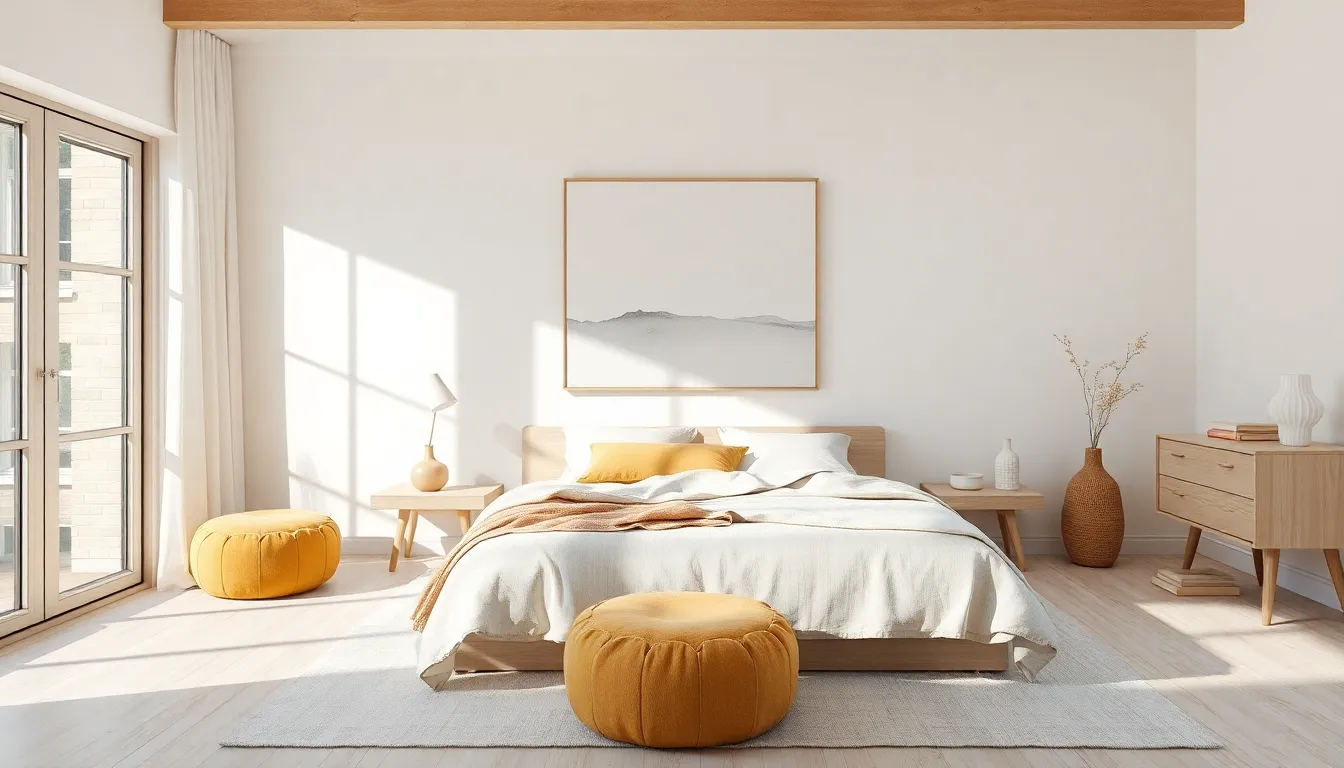
The foundation of any successful minimalist bedroom lies in its thoughtful color scheme. Neutral palettes create the perfect canvas for a serene, uncluttered space while allowing for subtle expressions of personality through carefully chosen accents.
Working with Whites, Creams, and Beiges
Modern minimalist bedrooms thrive on a base of whites, creams, and soft beiges for walls, flooring, and major furniture pieces. These neutral foundations instantly create an airy, open atmosphere that promotes relaxation and visual calm. Pale wood tones like oak or ash serve as perfect complementary elements, introducing warmth without disrupting the space’s tranquil feel. Consider incorporating crisp white bedding or a shiplap ceiling—a technique frequently used by Leanne Ford Interiors—to enhance the room’s sense of brightness and spaciousness. These neutral shades work together to create a timeless backdrop that won’t quickly fall victim to changing trends, making them a practical long-term investment for your minimalist sanctuary.
Adding Subtle Accent Colors
The key to maintaining minimalist integrity while avoiding visual monotony lies in thoughtful accent integration. Textured fabrics like linen bedding or wool throws add depth and dimension without introducing unnecessary visual noise. Muted tones can bring gentle personality to the space—consider a mustard yellow pouf or blush textile accents that provide color without overwhelming the neutral foundation. Natural materials offer another way to introduce warmth; a leather headboard or wood dresser brings organic elements into the room without compromising the clean aesthetic. Keep accessories purposeful and limited—a single oversized art piece or statement pendant light can serve as a focal point without cluttering the visual field. For pattern incorporation, stick to delicate geometrics or subtle stripes in neutral palettes rather than bold prints, and focus on tone-on-tone textures such as ribbed upholstery or woven rugs to add interest while maintaining the minimalist ethos.
Incorporating Natural Elements for Warmth and Texture
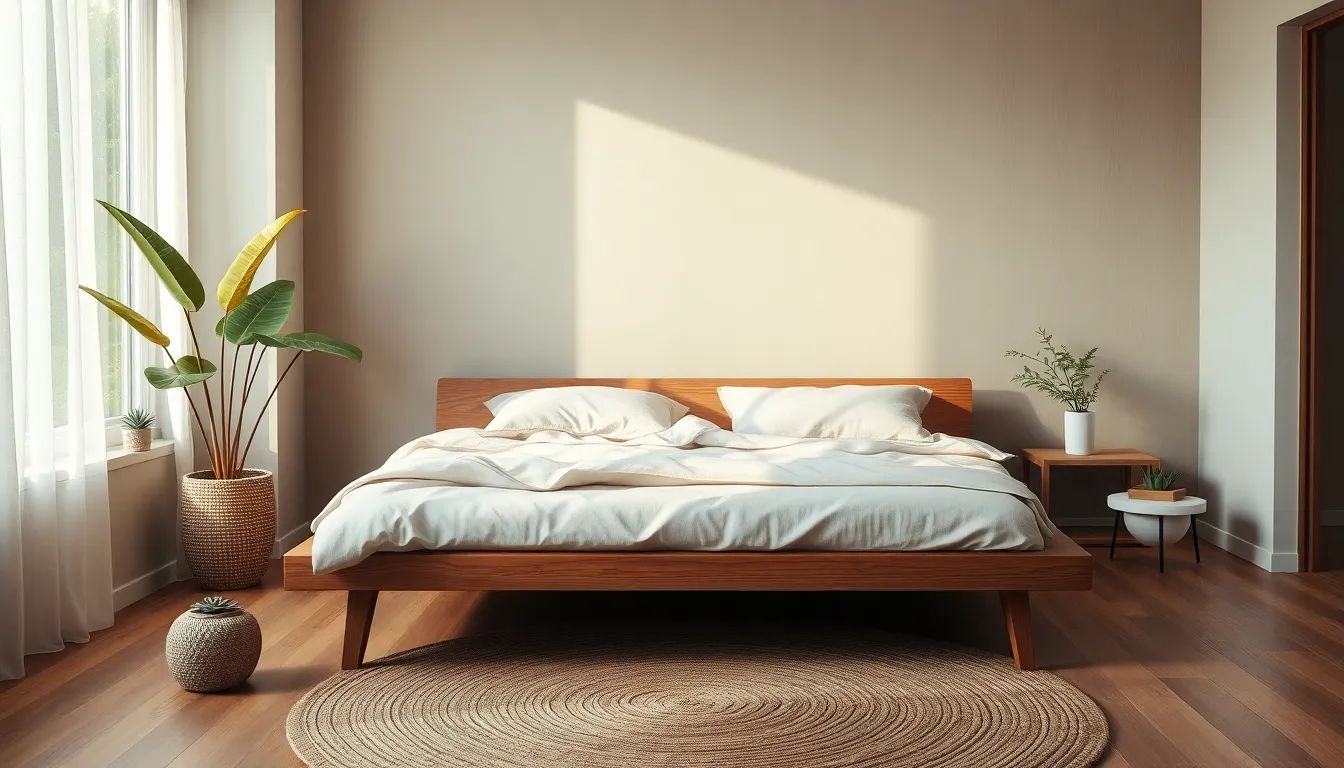
Natural elements are essential to soften the clean lines of minimalist design, creating spaces that feel both serene and inviting. By thoughtfully integrating organic materials, we can maintain simplicity while adding much-needed warmth and character to modern minimalist bedrooms.
Wooden Accents and Furnishings
Platform beds and low-profile wooden bed frames serve as perfect foundational pieces for minimalist bedroom designs. These pieces offer clean, uncluttered lines while eliminating visual noise that can disrupt the peaceful atmosphere. Warm wood tones found in leather headboards or simple dressers work beautifully to balance neutral color palettes, particularly whites and grays that might otherwise feel cold or stark. Floating wooden nightstands provide practical functionality without overwhelming your space, maintaining the room’s airy quality while adding organic warmth. The natural grain patterns in wood furnishings introduce subtle texture that creates visual interest without compromising minimalist principles.
Indoor Plants for Vitality and Clean Air
Strategically placed greenery breathes life into minimalist bedrooms while naturally improving air quality. Small, low-maintenance potted plants like succulents and snake plants require minimal attention yet complement streamlined aesthetics perfectly. Larger leafy varieties can function as stunning focal points when positioned thoughtfully near natural light sources, adding vertical interest without disrupting the room’s simplicity. Plants introduce natural color variation that works harmoniously with neutral palettes while providing proven benefits for both physical and mental wellbeing. Their organic shapes create a beautiful contrast against the geometric lines typically found in minimalist furniture, adding a ever-changing element that prevents the space from feeling too rigid or sterile.
Subtle Textures and Materials
Natural textiles offer an opportunity to soften minimalist spaces while maintaining their clean aesthetic. Linen bedding, jute area rugs, and wool throws introduce tactile variety that invites touch and creates depth. Subtle patterns like delicate geometrics or simple stripes on textiles can add visual interest without introducing clutter or complexity. Focus on materials with inherent textural qualities rather than excessive ornamentation—the slight irregularities in natural fibers provide enough visual complexity without overwhelming the space. These thoughtful texture additions create warmth and comfort while preserving the harmonious, pared-back ethos that defines minimalist design.
Optimizing Storage Solutions to Maintain Minimalism
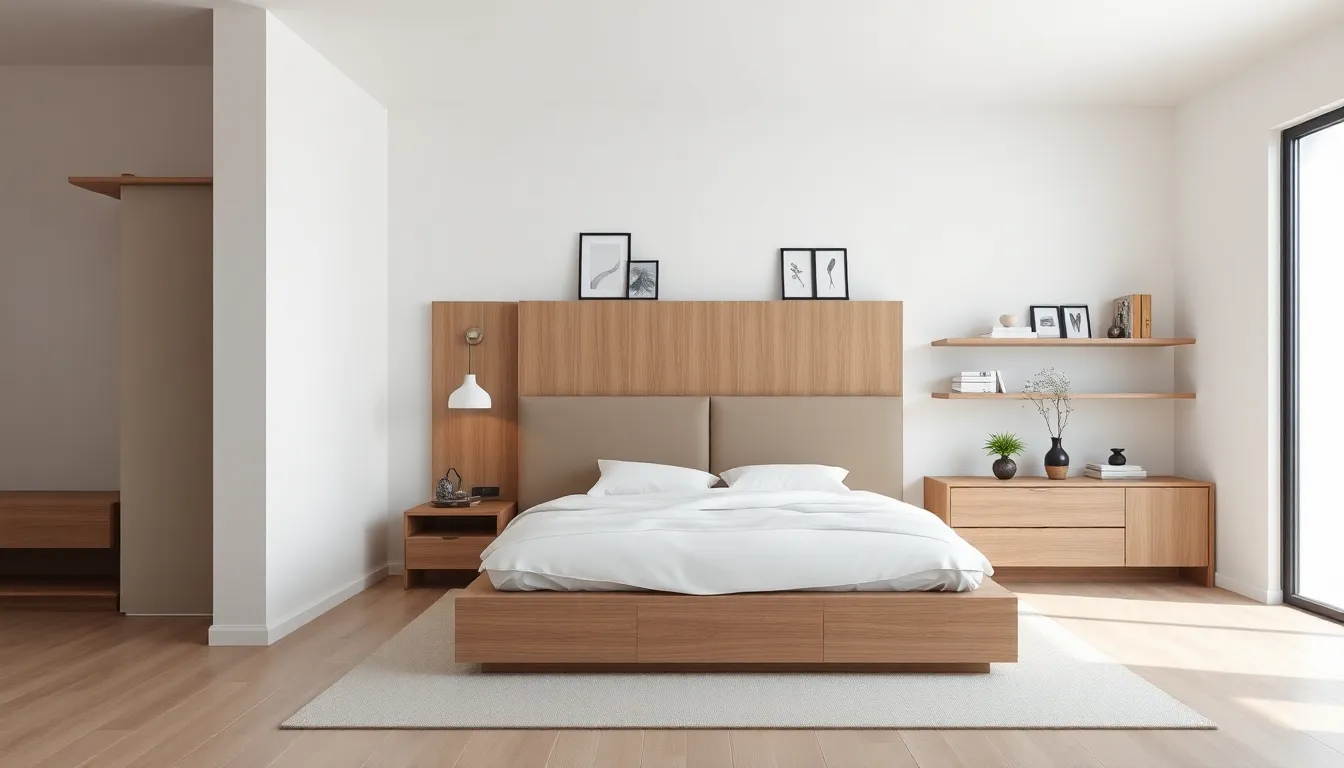
In minimalist bedrooms, concealed and multifunctional storage is essential for maintaining clean lines and reducing visual clutter. We’ve curated the most effective storage strategies that preserve the serene aesthetic while maximizing utility in your space.
Hidden Storage Options for Bedrooms
Platform beds with integrated drawers offer exceptional functionality by eliminating the need for additional furniture pieces. These clever designs provide discreet storage compartments for bedding, clothing, or seasonal items while maintaining the clean, uncluttered look essential to minimalism. Floating nightstands mounted directly to walls create valuable surface space without disrupting floor visibility, with many designs incorporating slim drawers for storing personal items. Upholstered benches or ottomans work double-duty as both seating and hidden storage, perfect for tucking away extra blankets, pillows, or books. Neutral-toned storage pieces in materials like light wood or matte finishes seamlessly blend with minimalist aesthetics, ensuring your storage answers complement rather than compete with your bedroom design. Built-in wardrobes featuring flush handles maintain those essential clean lines while providing ample organization space.
Wall-Mounted Storage to Maximize Floor Space
Floating shelves provide display areas for books, plants, or decorative objects without creating floor obstructions, helping maintain the open, airy feel crucial to minimalist spaces. Wall-mounted headboards with integrated cubbies incorporate recessed shelving for nighttime essentials like reading lamps, books, or small decorative items. Vertical storage units that extend from floor to ceiling use vertical space efficiently, particularly beneficial in smaller bedrooms where square footage is limited. These space-saving answers typically emphasize simplicity through materials like plywood, steel, or lacquered MDF that maintain visual lightness throughout the room. Color schemes for these storage elements generally feature muted tones such as white, gray, and beige to ensure they don’t visually dominate the space. By prioritizing wall-mounted options, we can preserve precious floor space while keeping essentials organized and accessible.
Selecting Minimalist Lighting for Ambiance and Functionality
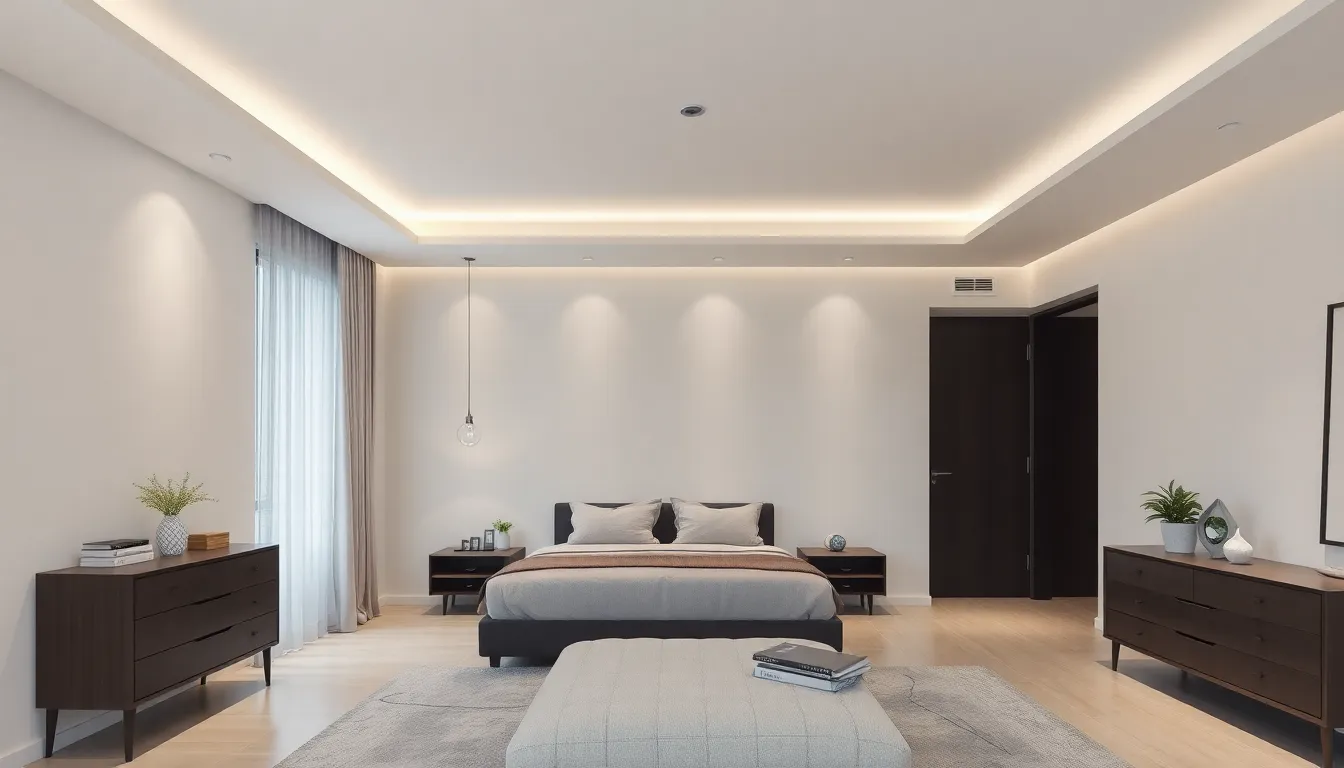
The right lighting choices are essential to achieving a truly modern minimalist bedroom. Effective lighting not only illuminates your space but also enhances the clean aesthetic that defines minimalism while providing the functionality needed for daily activities.
Recessed Lighting for Clean Ceiling Lines
Recessed lighting offers the perfect solution for minimalist bedrooms by maintaining uninterrupted ceiling lines. These fixtures sit flush with the ceiling, eliminating visual clutter and creating a sleek, contemporary appearance throughout your space. Their hidden nature allows light to emanate without drawing attention to the fixture itself, preserving the clean aesthetic that minimalism demands. Strategically positioned recessed lights can create focused pools of illumination exactly where needed, highlighting architectural features or creating ambient lighting that envelops the entire room. Many designers recommend installing recessed lights on dimmer switches to adjust brightness levels according to different activities and times of day, improving both the functionality and mood of your minimalist sanctuary.
Simple Pendant Lights and Sconces
Pendant lights and wall sconces with clean, understated designs serve as ideal complements to minimalist bedroom decor. These fixtures should feature basic forms without excessive ornamentation, focusing on simple geometric shapes and monochromatic finishes that align with minimalist principles. Wall sconces mounted beside the bed eliminate the need for bulky table lamps, freeing up nightstand space and contributing to the uncluttered feel of the room. Pendant lights with slender profiles can add a subtle decorative element while providing targeted illumination for reading or other bedside activities. Materials like frosted glass, brushed metal, or natural wood work particularly well in minimalist settings, offering subtle texture without overwhelming visual complexity. The key lies in selecting lighting that blends seamlessly with your space while providing the practical illumination necessary for comfort and functionality.
Creating Visual Impact with Thoughtful Textile Choices
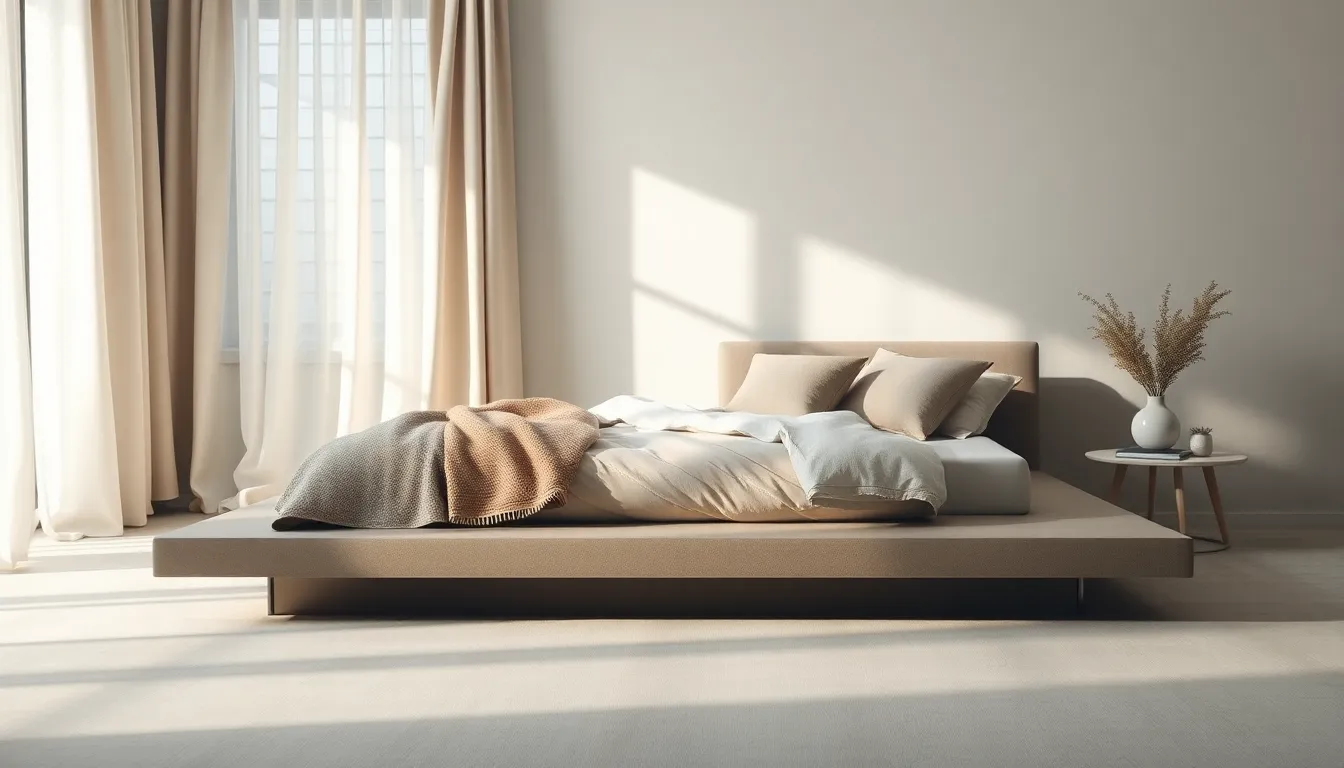
Minimalist bedrooms rely on carefully selected textiles to maintain tranquility while adding subtle dimension to the space. The right fabric choices can transform a sparse room into a sophisticated sanctuary without introducing visual clutter.
Quality Over Quantity in Bedding Selection
High-thread-count sheets in muted tones form the foundation of minimalist bedding design. White, ivory, and soft gray dominate modern minimalist bedrooms, as seen in Barcelona-based designs that pair unadorned platform beds with precisely customized bedding. Low-profile bed frames complement these refined textiles, creating a cohesive look that emphasizes clean lines and uncluttered surfaces. We recommend investing in organic cotton or linen materials that offer both breathability and understated luxury. These natural fabrics not only feel wonderful against the skin but also drape beautifully, improving the room’s serene quality without excess ornamentation.
Strategic Use of Throws and Pillows
Thoughtful accent pieces can inject warmth and personality while maintaining minimalist principles. A single statement item—like a mustard-yellow pouf or leather-accented headboard as featured in Marie Flanigan Interiors’ designs—provides visual interest without overwhelming the space. Limit decorative pillows to just 2-3 in tonal variations rather than competing patterns. Texture becomes the hero in minimalist bedrooms, with chunky knits or smooth leather creating tactile contrast against crisp bedding. Wall treatments also contribute to textile strategy, as seen in Studio Diaa’s whitewashed pine planked walls and Wendy Labrum’s taupe gingham pattern-drenched spaces that create monochromatic unity. Neutral linen curtains or semi-sheer window treatments, like those featured in Leanne Ford Interiors’ designs, maintain the room’s airy quality while softening natural light and completing the thoughtful textile industry.
Designing a Minimalist Bedroom Layout for Optimal Flow
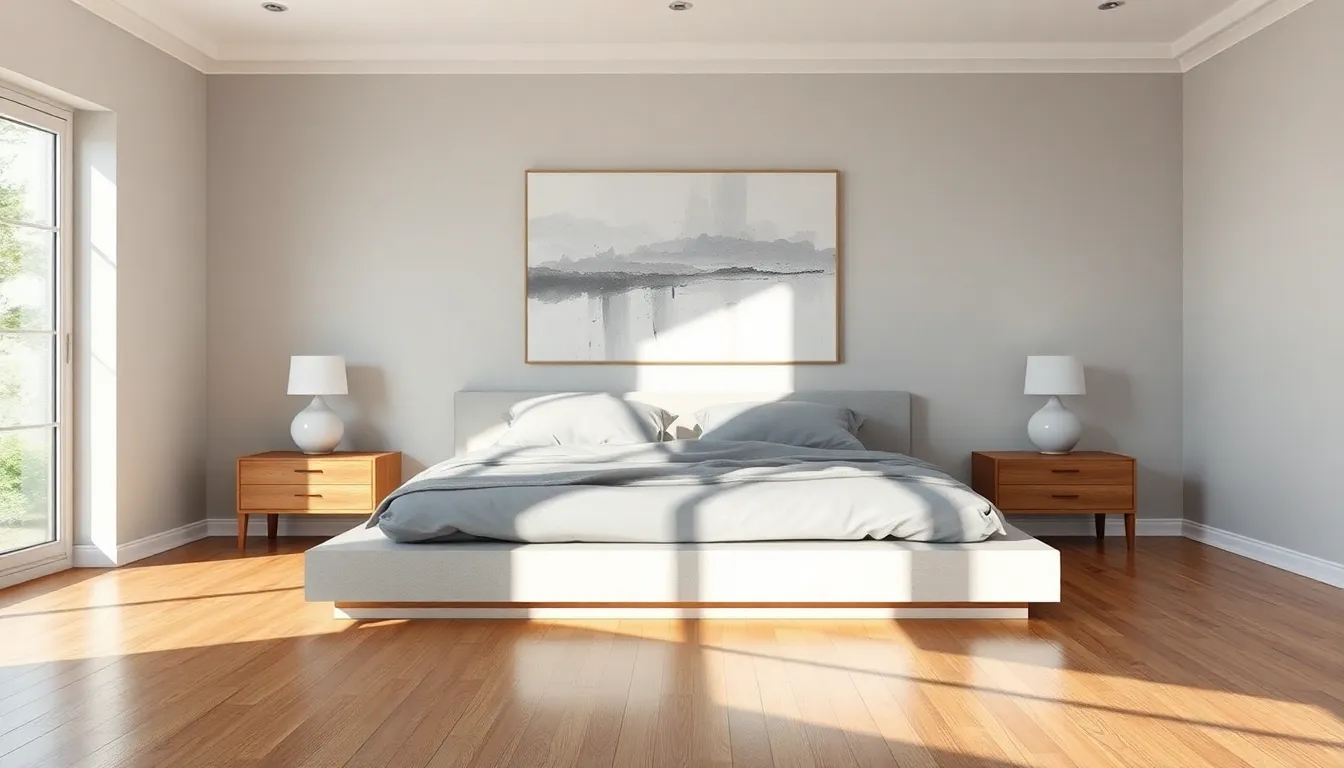
Creating a minimalist bedroom isn’t just about what you put in it—it’s about how you arrange those pieces to maximize function and tranquility. A well-designed layout enhances movement throughout the space while maintaining the clean aesthetic that’s central to minimalist design.
Creating Intentional Negative Space
Negative space serves as a powerful design element in minimalist bedrooms, allowing your eyes and mind to rest. We recommend limiting furniture to only the essentials, creating breathing room that makes the space feel more expansive and peaceful. Leave walls partially bare by selecting one large artwork rather than clustering multiple small pieces together. This approach creates focused visual interest without overwhelming the senses. Maintaining clear surfaces on nightstands and dressers prevents visual clutter from accumulating, reinforcing the minimalist aesthetic. Consider monochromatic color schemes using whites, soft grays, or warm wood tones to further enhance the perception of space. These neutral palettes create a cohesive backdrop that allows architectural features and carefully selected furniture to stand out organically.
Arranging Furniture for Balance and Harmony
Thoughtful furniture placement creates a bedroom that feels both balanced and functional. Position your bed as the focal point of the room, ensuring 3-4 feet of clearance around it for easy movement. Low-profile platform beds work beautifully in minimalist designs, as they maximize floor visibility and create an airy feel throughout the space. Incorporate symmetry by flanking your bed with identical nightstands and matching lamps, creating a sense of intentional order. Scale plays a crucial role in minimalist arrangements—choose proportional furniture pieces like streamlined dressers that prevent the room from feeling overcrowded. Add a single textural element such as a leather headboard or wood slat accent wall to anchor the space without introducing clutter. Floating nightstands mounted directly to the wall offer both function and visual lightness while freeing up floor space. Align furniture with existing architectural features like windows or ceiling beams to reinforce visual cohesion and create a seamless flow throughout your bedroom. Built-in storage options integrated under beds or within walls reduce visual noise while keeping essentials accessible and organized.
Choosing Artwork and Décor with Intentionality

In minimalist bedroom design, every piece must earn its place. We believe the secret to successful minimalist décor lies not in how little you have, but in how thoughtfully each element is selected.
Large-Scale Statement Pieces
Oversized artwork creates powerful focal points in minimalist bedrooms while maintaining the clean aesthetic. A single monumental piece in soft palettes—white, blush, or pale wood tones—perfectly complements high ceilings and simple lines, as exemplified in Chango & Co. designs. Architectural elements like midcentury-inspired geometric windows or strategically placed mirrors can function as built-in art that adds character without introducing clutter. When selecting statement pieces, consider the room’s proportions carefully—spacious walls call for larger artwork, while compact spaces benefit from more modest-sized pieces. Position your statement piece at eye level where it naturally draws attention without overwhelming the serene environment you’re cultivating.
Meaningful Over Many Decorations
Quality trumps quantity in minimalist bedroom décor, with emotional resonance and purpose guiding selection. Rather than scattered trinkets, we recommend choosing one carefully curated item per surface—perhaps a rich leather headboard with warm undertones or a mustard-yellow pouf for a subtle color accent. Floating nightstands and low-profile furniture reduce visual noise while creating an airy feel throughout the space. Natural materials introduce essential texture without excess—consider pale wood elements, linen bedding, or wool rugs layered thoughtfully. Reflective surfaces amplify natural light when positioned strategically, creating an illusion of expanded space. Monochromatic color schemes using varying shades of a single hue add depth while maintaining the serene atmosphere crucial to minimalist design. Texture layering through different materials invites tactile interest without compromising the clean simplicity that defines modern minimalism.
Incorporating Technology Discreetly in Your Modern Space

In today’s connected industry, technology plays an essential role in our bedrooms, but it shouldn’t disrupt your minimalist aesthetic. Smart devices and modern conveniences can seamlessly integrate into your space without creating visual clutter or compromising your design principles.
Cable Management Answers
Concealed channels offer an elegant solution for routing cords behind walls or along furniture edges, effectively eliminating cable eyesores. Adhesive cable organizers provide a simple yet effective way to tame unruly wires while maintaining your room’s clean lines. Furniture with built-in storage compartments, such as platform beds or nightstands, creates perfect hiding spots for power banks, chargers, and various cables. Wireless alternatives like battery-operated or rechargeable lamps eliminate the need for cords altogether, preserving your minimalist aesthetic. Smart power strips can be tucked behind furniture to consolidate multiple device connections into one organized location, reducing cable sprawl throughout your bedroom.
Hidden Tech Integration Ideas
Motorized blackout shades installed discreetly inside window frames provide automated light control without introducing bulky hardware into your space. Wall-mounted TVs paired with recessed outlets create a sleek entertainment option that can be concealed behind sliding panels when not in use. Headboard technology incorporates USB ports, ambient lighting, or built-in speakers into streamlined designs that maintain minimalist principles. Smart lighting systems controlled by voice or apps with recessed fixtures eliminate the need for visible switches and dimmers while improving your room’s ambiance. Wireless charging pads integrated directly into nightstands or bedside tables offer convenient device charging without messy cables. Smart thermostats and air purifiers with minimalist interfaces maintain essential functionality while blending seamlessly into your decor, proving that modern technology and minimalist design can coexist beautifully.
Maintaining Your Minimalist Bedroom: Habits and Practices
Creating a modern minimalist bedroom is just the beginning of your journey toward tranquility. The true essence lies in maintaining this peaceful sanctuary through daily habits and mindful practices.
We’ve explored how thoughtful design choices from neutral palettes to hidden storage answers can transform your bedroom into a haven of calm. Remember that minimalism isn’t about deprivation but intentionality.
To preserve your serene space make decluttering a regular ritual rather than a one-time project. Adopt the “one in one out” rule for new purchases and take a few minutes each evening to reset your bedroom to its calm baseline.
By embracing these minimalist principles you’ll not only enjoy a stylish contemporary bedroom but also experience the profound benefits of living with less – better sleep improved focus and a greater appreciation for the things that truly matter.
Frequently Asked Questions
What is modern minimalist bedroom design?
Modern minimalist bedroom design is an approach that embraces the “less is more” philosophy, focusing on clean lines, neutral colors, and clutter-free spaces. It creates a serene retreat by eliminating excess while maintaining style and personality through thoughtful furniture selection, intentional decor, and smart storage solutions. The goal is to foster a peaceful environment that enhances sleep quality and reduces stress.
How do I choose the right color palette for a minimalist bedroom?
Focus on neutral colors like whites, creams, soft grays, and pale beiges for walls and major furniture pieces. Add warmth with light wood tones and incorporate subtle accent colors for personality. Use textured fabrics and tone-on-tone patterns to create depth without overwhelming the space. Keep the palette cohesive and limited to maintain the airy, calming atmosphere essential to minimalist design.
What furniture is essential for a minimalist bedroom?
Stick to the essentials: a platform bed with clean lines, multi-functional nightstands (possibly floating or built-in), and minimal storage furniture. Choose pieces with dual purposes, like a bed frame with built-in drawers or a bench that offers seating and storage. Each item should serve a clear function while maintaining visual simplicity with clean lines and uncluttered design.
How can I incorporate natural elements into a minimalist bedroom?
Add wooden furniture or accent pieces for warmth and character. Include a few quality indoor plants to improve air quality and bring life to the space. Incorporate natural materials like linen, cotton, jute, or wool through bedding and textiles. Stone elements or ceramics can add subtle texture. These natural elements soften the clean lines typical of minimalist design.
What are the best storage solutions for maintaining minimalism?
Prioritize concealed and multi-functional storage to preserve clean lines. Opt for platform beds with integrated drawers, wall-mounted nightstands, and furniture with hidden compartments. Use floating shelves and vertical storage units to maximize floor space. Incorporate baskets or bins in neutral tones for smaller items. The goal is storage that complements rather than competes with your minimalist aesthetic.
How should I approach lighting in a minimalist bedroom?
Choose simple fixtures that provide both function and subtle style. Consider recessed lighting for clean ceiling lines, simple pendant lights as focal points, and wall sconces to save space. Focus on basic forms and quality materials that complement your neutral palette. Layer lighting with dimmers to create adaptable ambiance while maintaining the uncluttered appearance essential to minimalism.
What type of bedding works best in a minimalist bedroom?
Select high-quality bedding in natural materials like organic cotton or linen in neutral tones. Limit decorative pillows to 2-3 in complementary colors or subtle textures. Choose simple duvet covers or quilts with minimal patterns. Focus on tactile comfort and visual simplicity rather than elaborate designs. Quality bedding enhances the room’s tranquility while maintaining the clean aesthetic.
How do I arrange furniture in a minimalist bedroom?
Position your bed as the focal point with adequate walking space around it. Create intentional negative space by limiting furniture to essentials and keeping some walls bare. Use symmetry with matching nightstands when possible, and align furniture with architectural features. Maintain clear pathways and ensure each piece has breathing room. This thoughtful arrangement enhances flow and tranquility.
How should I select artwork and décor for a minimalist bedroom?
Choose fewer, more impactful pieces rather than numerous small items. Select one or two large-scale artworks that resonate emotionally and complement your color scheme. For décor, prioritize quality over quantity and ensure each item serves a purpose or holds significant meaning. Consider monochromatic pieces or those with subtle textures to maintain visual calm while adding interest.
How can I integrate technology while maintaining minimalist design?
Use discreet cable management solutions to hide cords and wires. Choose furniture with built-in charging stations or storage for devices. Opt for wireless alternatives like battery-operated lamps when possible. Consider hidden tech integration such as wall-mounted TVs, motorized window treatments, or smart lighting systems that can be controlled remotely. Technology should enhance functionality without disrupting visual simplicity.

